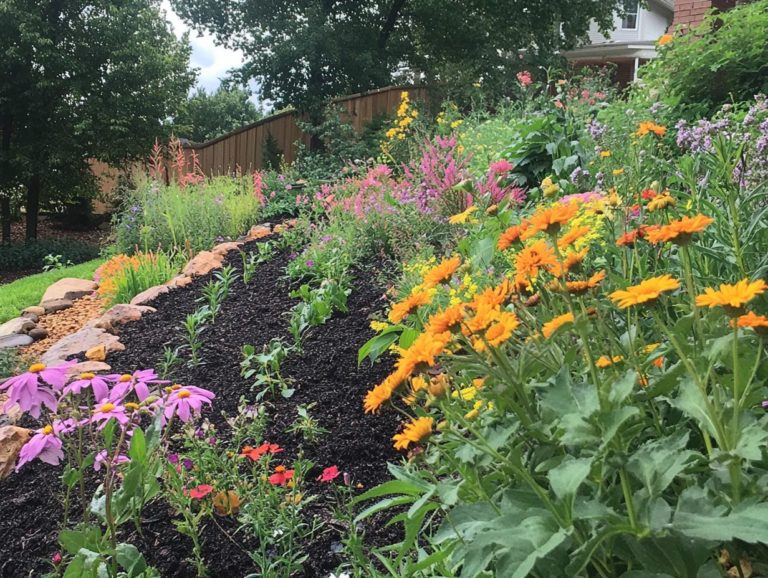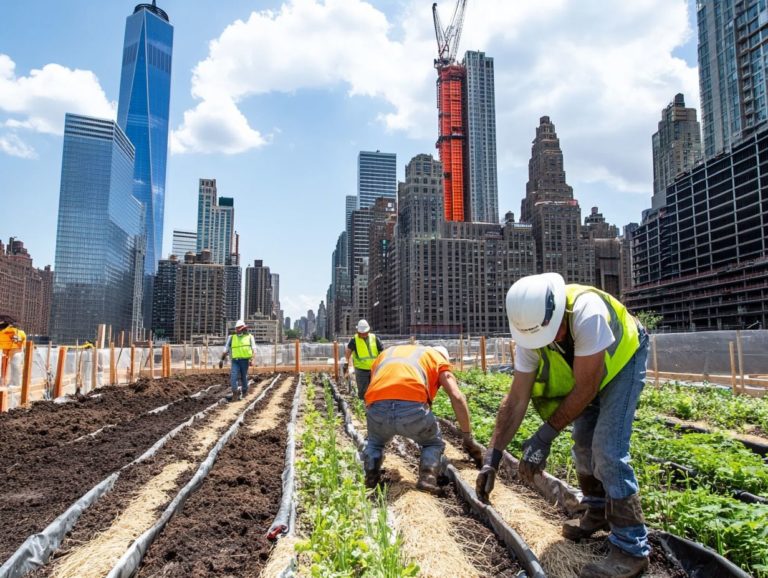The Benefits of Soil Retention Structures
Soil retention structures are game-changers for land management! They help prevent erosion, enhance water retention, and boost agricultural productivity.
This article explores various types of soil retention structures, both natural and man-made, highlighting the numerous environmental and agricultural benefits they provide.
You will find important design considerations, maintenance tips for longevity, and a cost-benefit analysis to guide your investment decisions.
Discover how these structures can rejuvenate landscapes and promote sustainable practices.
Contents
- Key Takeaways:
- What are Soil Retention Structures?
- The Importance of Soil Retention
- Explore Various Soil Retention Structures
- Designing and Building Soil Retention Structures
- Maintaining and Repairing Soil Retention Structures
- Cost and Cost-Benefit Analysis of Soil Retention Structures
- Frequently Asked Questions
- What are soil retention structures?
- What are the benefits of using soil retention structures?
- How do soil retention structures prevent erosion?
- What types of soil retention structures are commonly used?
- How do soil retention structures improve water quality?
- Can soil retention structures be used in residential landscaping?
Key Takeaways:

- Soil retention structures stop soil erosion and improve water drainage. This results in a healthier environment for agriculture and ecosystems.
- Natural and man-made soil retention structures, like terraces and retaining walls, can be tailored to meet specific landscape and soil needs, ensuring long-term sustainability with proper maintenance.
- Although the initial cost of soil retention structures may seem high, a cost-benefit analysis shows their long-term benefits and savings by preventing soil loss, increasing crop yields, and protecting surrounding areas from potential damage.
What are Soil Retention Structures?
Soil retention structures are carefully designed systems that help prevent soil erosion and provide support for the ground across various landscapes, such as tiered terrains and retaining walls.
They are essential for managing water runoff, reducing flood risks, and preserving soil integrity, all of which help minimize potential property and foundation damage.
Consider companies that specialize in crafting these vital systems, enhancing both functionality and the aesthetic appeal of residential and commercial properties.
Definition and Types
Soil retention structures encompass various designs. Retaining walls not only enhance the beauty of your landscape but also effectively combat soil erosion.
You can choose materials like concrete and masonry, each offering unique advantages. Concrete retaining walls are known for being strong and long-lasting, ideal for supporting heavy loads and withstanding harsh weather conditions. In contrast, masonry walls built with bricks or stones offer a classic charm that blends seamlessly with natural surroundings.
Both options can be creatively integrated with landscaping elements, such as lush vegetation or decorative features, enhancing their functionality while creating stunning outdoor spaces.
The Importance of Soil Retention
The significance of soil retention is crucial; it acts as a barrier against soil erosion, preserving the structure of the soil and enhancing agricultural productivity. It also plays an essential role in nurturing the variety of plants and animals in an area and facilitating flood control within diverse ecosystems.
Environmental and Agricultural Benefits
Soil retention structures provide remarkable environmental advantages, boosting agricultural productivity by maintaining soil structure and organic matter. This supports biodiversity and aids in flood control.
Techniques like terraces and contour plowing effectively slow down water runoff, allowing moisture to penetrate deeper into the ground. This process nurtures a richer layer of organic matter. For example, using these methods can increase crop yields by as much as 30%, as evidenced in regions of Africa where drought-resistant crops thrive in enriched soils.
By promoting biodiversity through various planting, you can increase resilience against pests and diseases, contributing to a healthier ecosystem. Proper soil retention can reduce flood risks by up to 50% in vulnerable areas, protecting agricultural lands and surrounding communities.
Act now to protect your land and enhance its productivity!
Explore Various Soil Retention Structures

You have a range of soil retention structures at your disposal, both natural and engineered. Options include retaining walls, terraces, and natural methods that use plants and soil.
Each option is specifically designed to manage soil erosion and runoff effectively. This ensures the stability and health of your landscape.
Natural and Man-Made Structures
Natural soil retention structures, such as vegetation and terracing, enhance man-made solutions like retaining walls and bioengineering techniques. This powerful combination is key to tackling soil erosion.
Integrating deep-rooted plants with retaining walls stabilizes the soil and boosts biodiversity by creating habitats for various species. While man-made solutions can deliver quick results, they may miss the ecological benefits of natural methods.
Adopting a balanced approach leveraging both natural and engineered structures yields more sustainable and visually appealing landscapes, fostering a resilient ecosystem that meets the needs of all stakeholders.
Designing and Building Soil Retention Structures
When designing and constructing soil retention structures, carefully consider various factors. These include soil characteristics, water runoff dynamics, and the specific functional benefits you aim to achieve.
Collaborating with a qualified retaining wall contractor is vital to ensure successful implementation and to effectively navigate these complexities.
Factors to Consider and Best Practices
Key factors in designing soil retention structures include soil characteristics, water runoff patterns, and the potential impacts on nearby ecosystems. These elements are essential for guiding best construction practices.
Understanding soil characteristics is crucial. The type and composition of the soil dictate how well your structure performs under various conditions. For instance, clayey soils may excel at retaining water but create drainage challenges. In contrast, sandy soils allow for swift runoff, leading to erosion.
Evaluating water runoff patterns helps you anticipate how drainage systems will handle different weather events. This foresight can prevent overflow and potential damage. Recognizing the impact on nearby ecosystems is crucial for preserving local flora and fauna.
By following these best practices during both the planning and execution phases, you can significantly enhance the structural integrity and longevity of soil retention systems, contributing to more sustainable land management.
Maintaining and Repairing Soil Retention Structures
Maintaining and repairing soil retention structures is vital to keep them working well for years to come. This is especially true for retaining walls, which require regular inspections and proactive measures to identify and address potential issues before they escalate.
Tips for Long-Term Sustainability

For the long-term sustainability of your soil retention structures, make regular maintenance a top priority. Monitor soil health and implement effective erosion control practices. These strategies ensure optimal performance over time.
Engaging in these activities sustains the structural integrity of your retention systems and enhances the surrounding ecosystem. Planting native vegetation can serve as a natural barrier against erosion while promoting biodiversity. Incorporating natural amendments like compost or mulch boosts soil health and helps retain moisture and nutrients.
Regularly inspect these structures for any signs of wear or displacement. Timely repairs can prevent erosion issues from escalating. By adopting proactive measures, you not only preserve your soil retention systems but also contribute to a healthier environment overall.
Take action today to protect your land and enhance your ecosystem!
Cost and Cost-Benefit Analysis of Soil Retention Structures
Doing a detailed cost analysis of soil retention structures is crucial to immediately assess the investment needed for construction and understand their long-term effectiveness in preventing soil erosion and protecting property from damage.
This careful evaluation allows you to make informed decisions that align with both financial and environmental goals.
Evaluating the Investment
Evaluating your investment in soil retention structures means taking a close look at the costs tied to construction, maintenance, and the potential economic perks of preventing soil erosion and related property damage.
Several key factors play a crucial role in determining these costs, such as the types of materials you choose, the complexity of your site, and the local regulations that govern construction practices. It’s essential to consider how factors like soil type and moisture levels can influence both the design and longevity of these structures.
Engaging with a knowledgeable retaining wall contractor is vital; they ll provide you with accurate assessments of initial costs and help you plan for ongoing maintenance expenses. With expert guidance, you’ll keep your budget on track while unlocking amazing long-term benefits of enhanced property stability and value. Making informed decisions about soil retention is an invaluable aspect of your construction project.
Frequently Asked Questions
What are soil retention structures?
Soil retention structures are human-made structures designed to stabilize soil and prevent erosion. They are often used in landscaping, construction, and agriculture.
What are the benefits of using soil retention structures?

Soil retention structures offer a range of benefits, including preventing erosion, improving water quality, and creating a more stable and usable landscape.
How do soil retention structures prevent erosion?
Soil retention structures use various techniques such as terracing, gabions, and retaining walls to hold soil in place and prevent it from being washed away by wind or water.
What types of soil retention structures are commonly used?
Common types of soil retention structures include retaining walls, riprap, geotextiles (fabrics used to reinforce soil), and slope stabilization techniques like planting vegetation and grading.
How do soil retention structures improve water quality?
Soil retention structures help to prevent sediment and pollutants from entering bodies of water, improving the quality of water for both humans and wildlife.
Can soil retention structures be used in residential landscaping?
Yes, soil retention structures can be used in residential landscaping to prevent erosion, create terraced gardens, and improve the appearance and functionality of a yard.
For tailored advice on your soil retention needs, consider consulting a professional.






